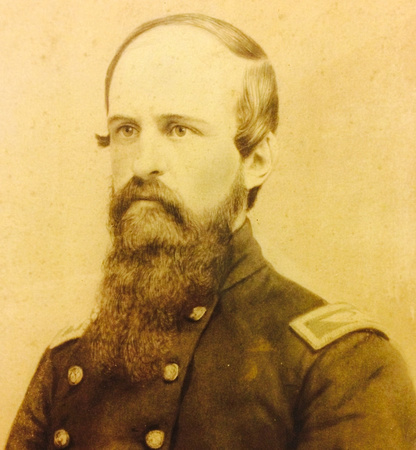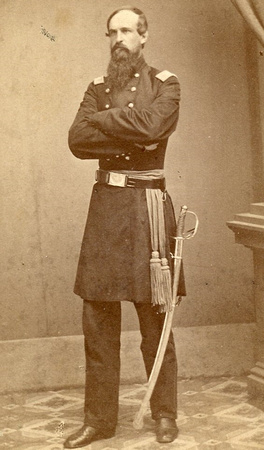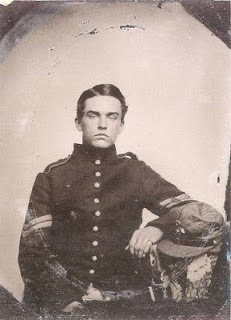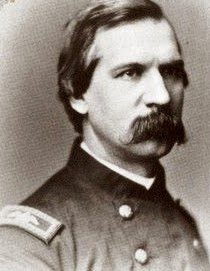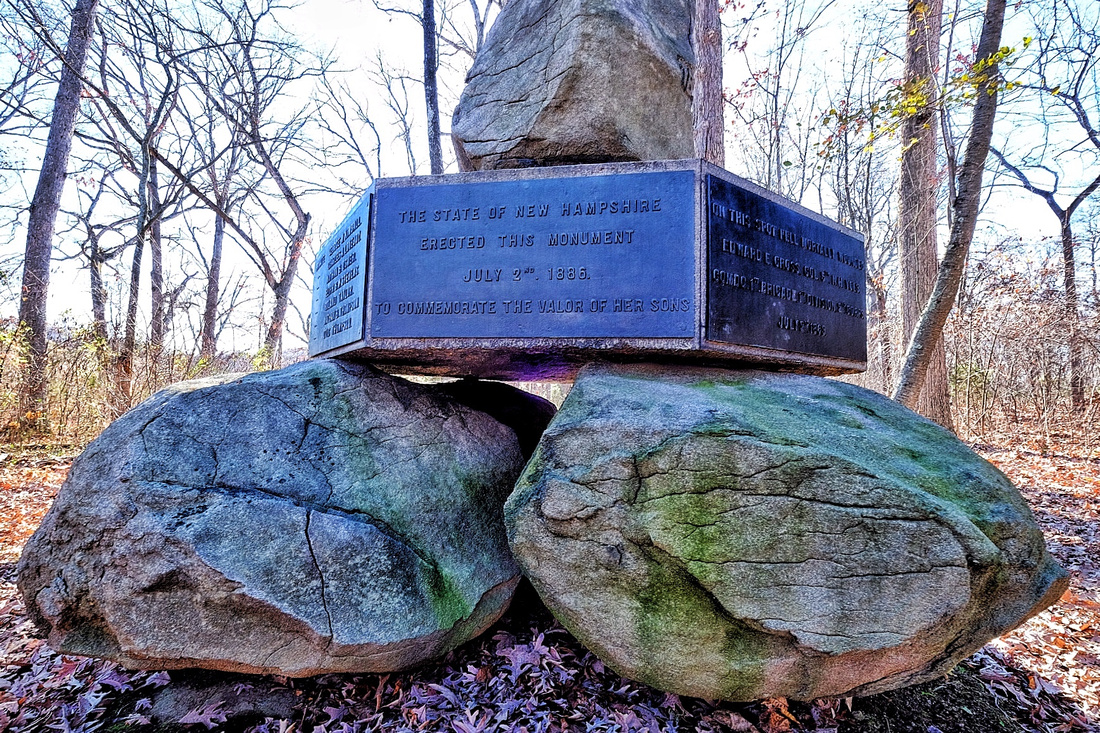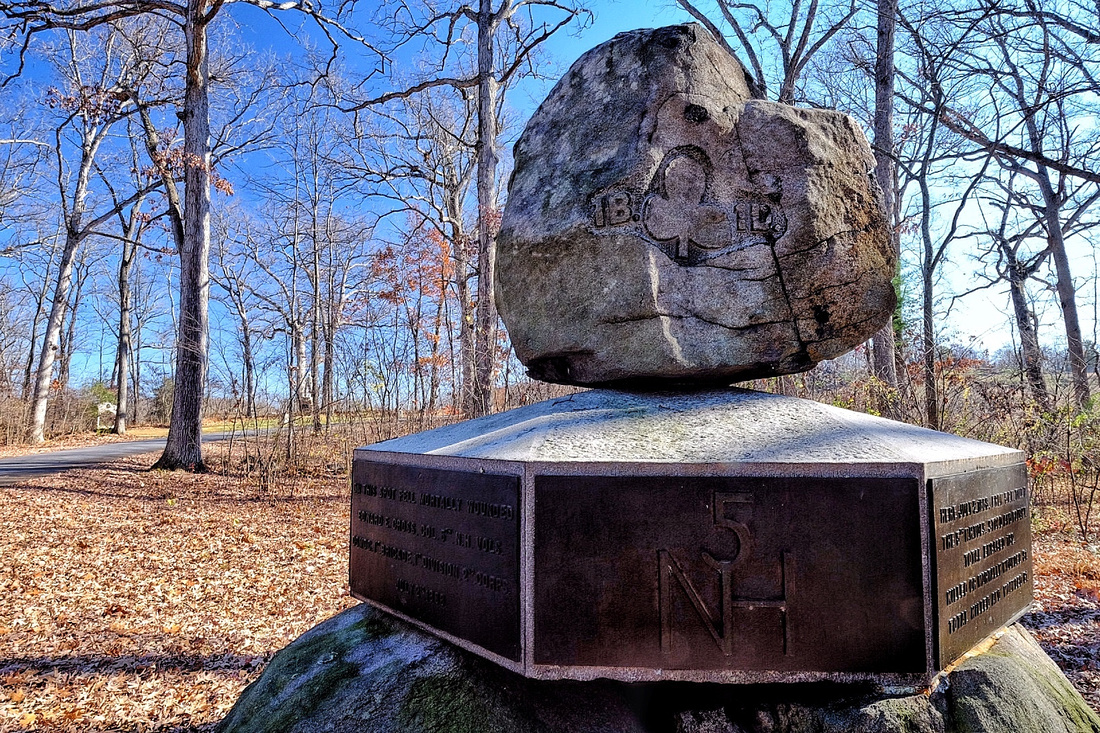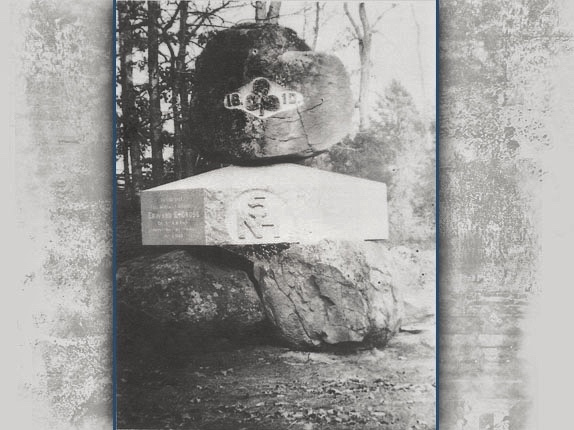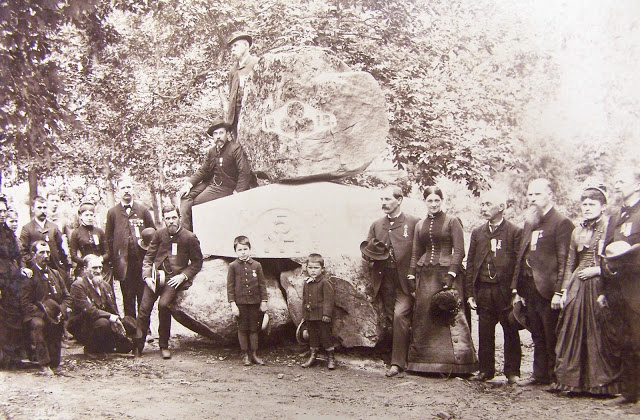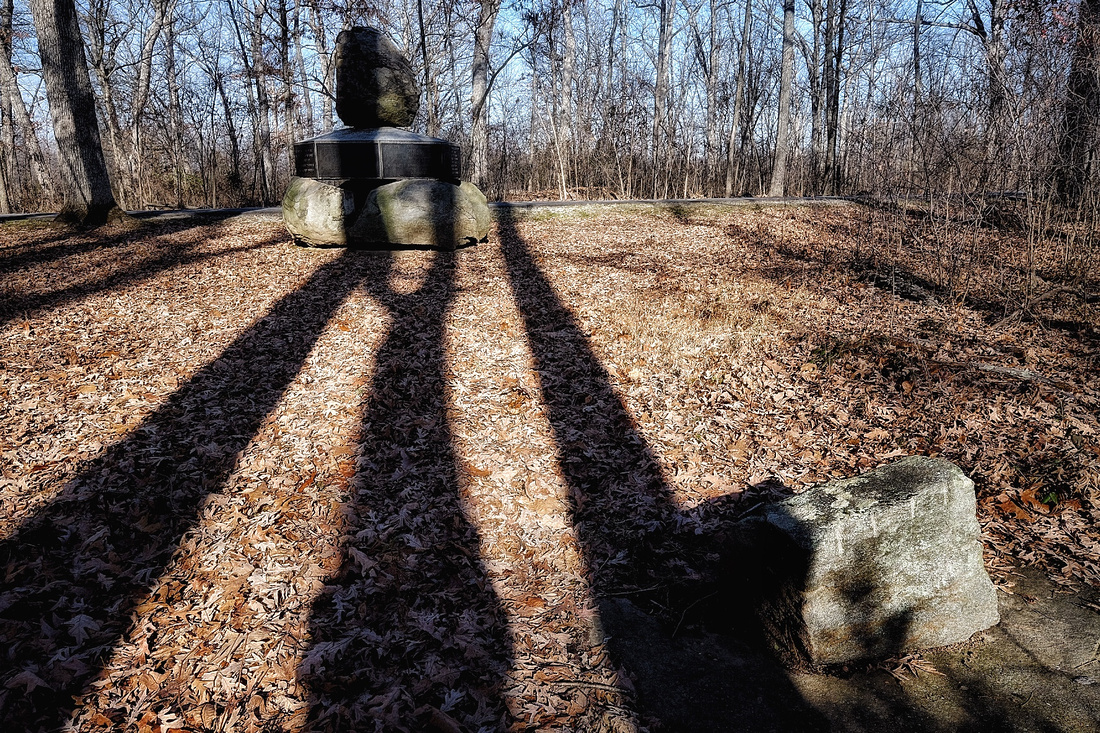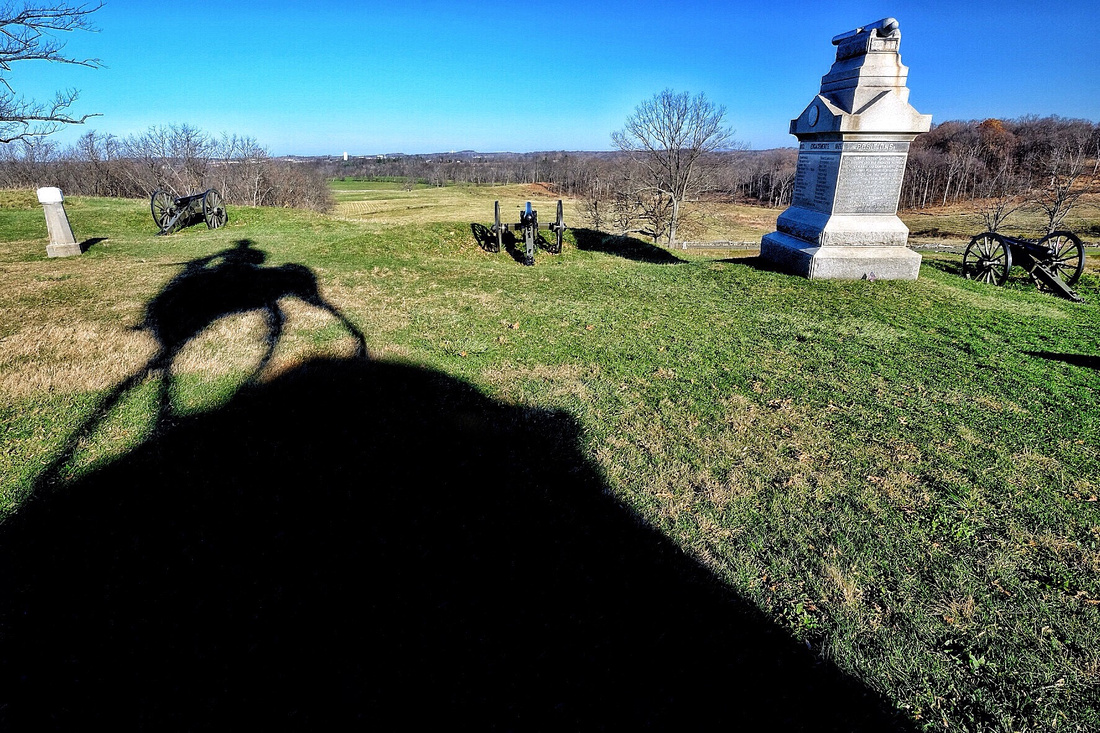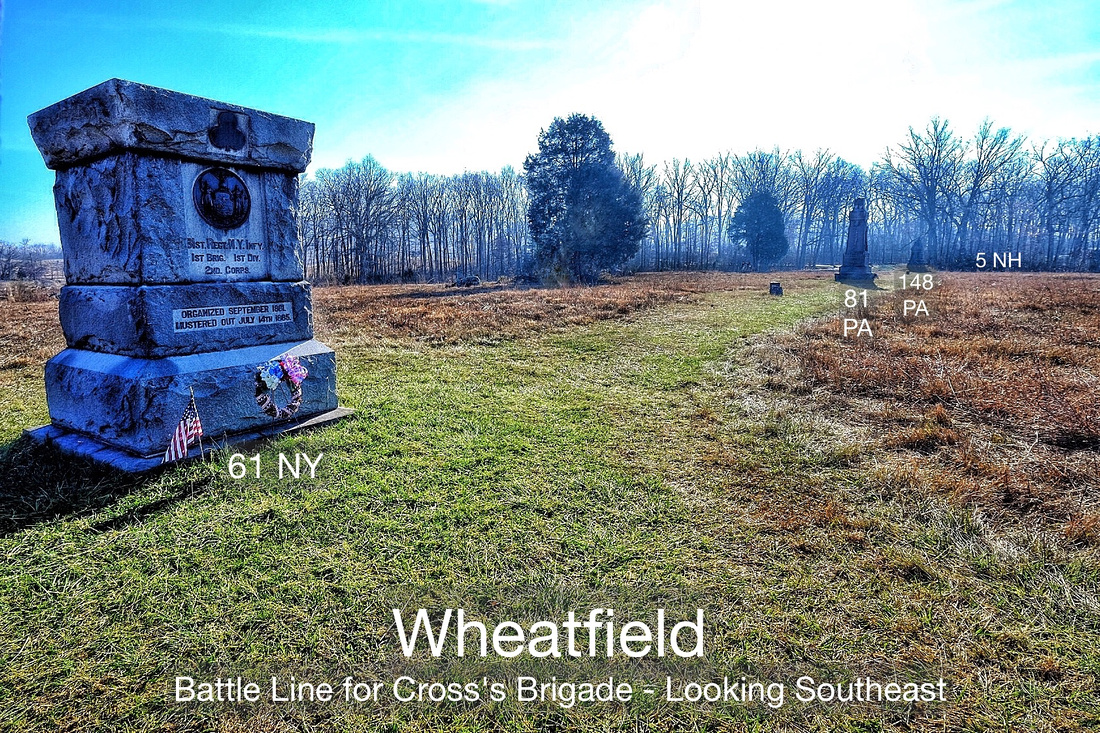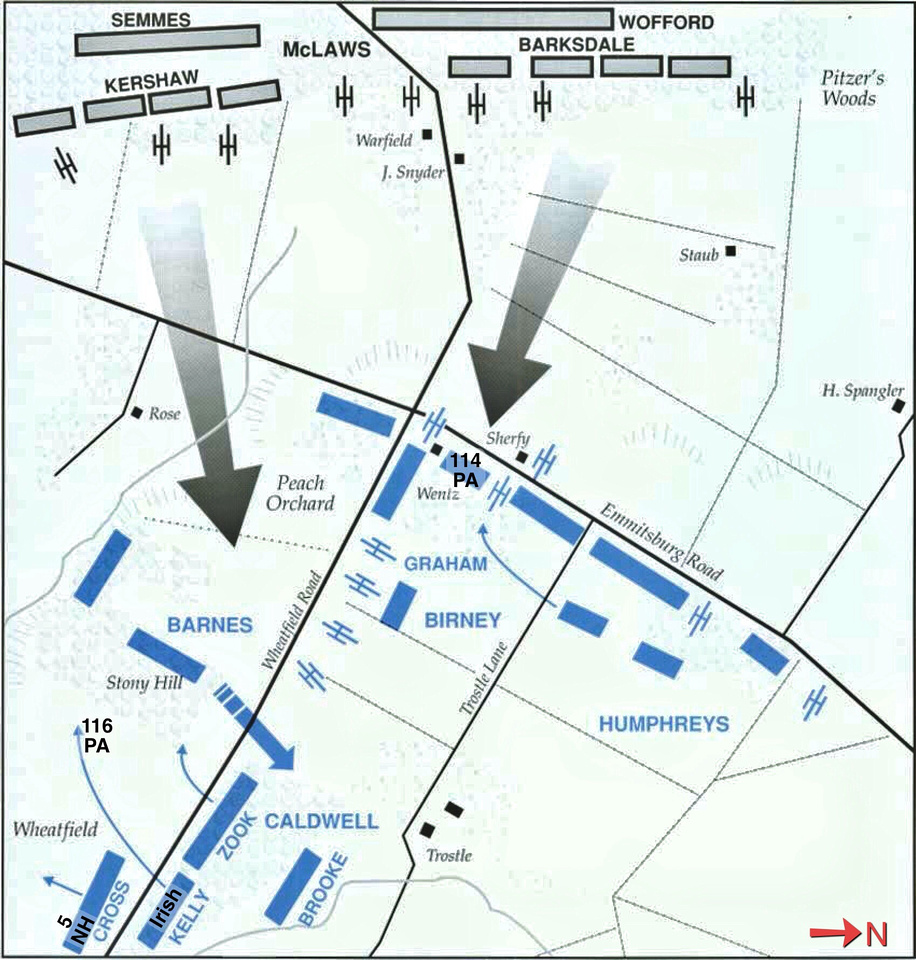The Honored Dead at Gettysburg
Make no mistake, the Civil War era is filled with many fascinating military characters. The most gifted fictional writers could not have invented a more colorful character than the Confederate General, Stonewall Jackson. But for the Union, not many, if any, are more intriguing and compelling than the grim warrior, Edward E. Cross, Colonel of the 5th New Hampshire regiment and brigade commander at the Battle of Gettysburg.
Cross crammed much 19th century adventure in a short time span. He was well traveled for his young age. Early on he was a newspaper reporter and editor in Cincinnati. Then he moved out West and worked in the mining business, became a trapper, buffalo hunter, explorer, and part-time Indian scout and fighter. He fought two duels, one involving rifles and the other with swords, with people who had differences with some of his editorial opinions. All of this accomplished before the age of 27. He was 31 years old while leading an Army of the Potomac brigade at Gettysburg.
At 6'3" tall, he projected a commanding presence. He was energetic, tenacious, outspoken, demanding, abrupt, impulsive, non-conforming, possessed a quick temper and showed favoritism. What's not to like about this guy? These traits resulted in many of his soldiers abhorring him and probably affected his absence of a military promotion. As evidence, prior to Chancellorsville, he was appointed to command the First Brigade of Winfield Scott Hancock's old division , but he was not honored with a brigadier general's star. And the soldiers of the 148th PA considered him a tyrant when he sacked their regiment's Colonel a day prior to the battle.
Cross was at one time a member of the anti-immigration American Party (formerly the Know-Nothing Party). He believed in the superiority of the white Protestants over Irish Catholics, Mexicans, and American Indians. He loathed abolitionists and blacks alike. At some point however, he must have gotten past his prejudices when ordered to advance his brigade behind the Irish Brigade (see my blog on The Devotion at Gettysburg) up the hill to the formidably held stone wall at Marye's Heights, during the Battle of Fredericksburg. One Second Corps biographer stated "that the bodies found nearest at the stone wall were those of the Sixty-ninth New York, Fifth New Hampshire, and Fifty-third Pennsylvania."
Cross was known by his men as a grim warrior who was brave and cool under fire. He was wounded thirteen times during the regiment's heavy campaigning from 1861-1863. His first wound at the Battle of Fair Oaks kept him out of action for two months in 1862. After suffering wound numbers 6-11 at the Battle of Fredericksburg, Cross was laid low for three months prior to returning to the fight at Chancellorsville. "If all the colonels in the army had been like him we should never have lost a battle," said one of his men. By the end of the war, the New Hampshire regiment had more battle deaths than any of the other 2,000 some Union Army regiments.
In the feverish climax at the Bloody Lane fighting at Antietam, Cross, recalling his Indian fighting days, exhorted his men to "Put on the war paint!". With his red bandana customarily affixed to his head (evidently for easy identification of the commander during the heat of battle), the wounded Cross then smeared his bloody face with gunpowder from a nearby torn cartridge. "Give 'em the war whoop boys!" Cross exclaimed. His men obediently smeared black powder on their own sweaty faces, gave out an Apache war cry and defiantly stood their ground in the face of an attempted Rebel flanking maneuver. From that moment onward, they became known as the Fighting Fifth. Oh my, you just can't make this stuff up. With all of his character faults, this man was a born warrior and leader of men. Prior to his mortal wounding at the Bloody Lane at Antietam, Major General Israel Richardson is quoted as saying, "If I was going to take Hell, I should want the 5th for skirmishers".
On June 28th, preceding the Battle of Gettysburg, Cross told his aide, Major Charles A Hale, "It will be my last battle". Per Hale, later in the day of June 28 - "At last he said to me; "Mr. Hale, I wish you to attend to my books and papers; that private box of mine in the headquarters wagon; you helped me re-pack it the other day. After the campaign is over, get it at once, dry the contents if damp, and then turn it over to my brother Richard." At 3pm on July 2nd, Cross's premonition of death carried over to his selection of the color of his normally worn battle bandana. Per Hale: "The Colonel had for some time been walking back and forth in his quick nervous way, his hands clasped behind his back, a habit that was usual with him. Presently, stopping short where I was standing, he drew out from an inside pocket a large new black silk handkerchief; arranging it in folds on his lifted knee, then handing me his hat to hold, he quickly swathed his head with it in turban fashion, tying the two ends behind. We had seen him do this on other fields with a red bandanna and it then amused me somewhat, but under the peculiar circumstances of the few days previous that black handkerchief was appalling. Again he took off his hat, saying "please tie it tighter Mr. Hale"; my hands were trembling as I picked at the knot; "draw it tighter still" he said impatiently, and finally I adjusted it to suit him. By this time the firing was working up towards the right from the Peach Orchard1 while south by the Round tops there was a struggle going on that seemed to be working to our rear." Shortly thereafter, per Hale: "About this time General Hancock came riding up from the left accompanied by his staff, and for a moment he drew up where Colonel Cross was standing at his horse's head. "Colonel Cross, this day will bring you a star," he said in his measured suave manner but the Colonel gravely shook his head as he replied, "No General, this is my last battle;" he spoke calmly, with no apparent emotion, and as the General rode on, turned his attention out in the direction of the Peach Orchard, where the battle was now raging at a white heat." The four regimental units of the First Brigade led by Cross departed the Trostle Woods and advanced though the Wheatfield and the eastern woods bordering the field. After dismounting from his horse near the right flank of the 148th PA, Cross stood in the wheatfield, looked ahead into the tree canopy of the Rose Woods and Stony Hill, and gave his final instructions to his officers "to be ready to charge when the order is given". He then made his way to his left into the trees where the remainder of the Fifth NH was positioned so that he could lead the First Brigade attack. As he neared his old regiment, he was shot through the lower abdomen. A sniper located in a boulder cleft some forty yards southwest from Cross’s position brought him down. Lt. Colonel Hapgood, who witnessed the shooting, ordered Sergeant Charles Phelps to kill the Confederate sniper. Phelps provides retribution by taking down the sniper with a crack first shot as ordered by the regimental commander. Phelps was later felled with a mortal wound to the back. As Cross lay dying in the woods, Frank Butler, a captain in the 5th, stated in a July 5th letter that "Cross begged for chloroform". Per Butler, “Blow my brains out,” Cross screamed. “Shoot me. How long must I live in such pain?”. Caldwell is aware that the First Brigade is under heavy fire and relieves most of the brigade (the Fifth holds their position until Brooke's Brigade retreats) by committing the reserve troops under Brooke, which eventually sweeps across the Wheatfield maelstrom and momentarily drives the Rebels off the Stony Hill. The First Brigade retires to Cemetery Hill under their succeeding commander, Colonel McKeen.
Cross was taken to a field hospital, very likely the William Patterson Farm (about a mile northeast of the Wheatfield) where he died the next day about six hours after being struck in the gut by a minie ball. His last words were, "I think the boys will miss me." From a local New Hampshire Newspaper Obituary: "As an officer, he was a strict and unswerving disciplinarian, punishing with severity any shirking or neglect of duty....He never asked his men to go where he would not go, and they did well if they followed closely where he led......He was a kind friend, a good son and brother, a brave and chivalric soldier. Devoting his life to his country, he yielded it up in its prime, and passed away while the nation is yet convoluted with the throes of rebellion." In 1866, Winfield Scott Hancock said, "What a magnificent fighter Cross was." Known by his Army colleagues as Hancock "the Superb", that is quite a complement to receive.
The monument to the 5th New Hampshire regiment was dedicated on July 2nd, 1886, 23 years to the day after the noted struggle in the Wheatfield. It is one of the most unassuming structures at the Gettysburg National Military Park (GNMP) but yet probably the most unique. Three field boulders from Gettysburg form the base of the unit with an octagonal shaped white Concord, New Hampshire granite sandwiched between another field boulder on top. With the Colonel's name being engraved on one of the plaques, 30 additional "honored dead" (Lincoln) names are listed as having given their "last full measure of devotion" (Lincoln). This monument is one of the few at the GNMP which identify the names of those soldiers who were killed or mortally wounded during battle. The six and a half-foot tall monument symbolizes the “hard, enduring, patient, and unmovable” men of the Granite State. Originally the large monument to the 5th New Hampshire did not have any bronze plaques around the side, which were added in 1901. At the monument's dedication in 1886, we can see below a view of it with its light-colored Concord granite octagon. It is worthy to note that although Cross may have ruffled the feathers of many a soldier who had to answer to him, these war-tested veterans respected him enough to erect a monument at the spot where he fell and to dedicate his memory solely to one of the eight plaques surrounding the structure. His portrait hangs prominently on the first floor of the Statehouse of New Hampshire as one of the finest heroes in the history of that state.
Note1: Be sure to watch out for my next blog post on The Struggle at Gettysburg (The 114th Pennsylvania and Barksdale's Charge through Mr. Sherfy's Peach Orchard).
Note2: Recommended reading, My Brave Boys, by Mike Pride and Mark Travis
Note3: For more about Colonel Cross, see, Mike Pride - Our War Blog
Note4: For more about Colonel Cross and the 5th New Hampshire at Gettysburg, see, Gettysburg Daily
Note5: Be sure to watch out for my upcoming blog post on The Wounded at Gettysburg (The Extraordinary Charles A. Fuller and the 61st NY at the Wheatfield).
Note6: Be sure to watch out for my upcoming blog post on The Sacrifice at Gettysburg (The 4th Michigan Seizes the Colors in the Wheatfield).
For some absorbing anecdotes concerning the Army of the Potomac, see Dr. Timothy Orr's blog: Tales from the Army of the Potomac.
My full Gettysburg gallery of photographs can be found at D.W. Orr Gettysburg Gallery.
D W Orr
Environmentalist, Historic Preservationist, Weimaraner Companion, Blogger, and Photographer
Harford County, Maryland
January 9, 2016
Colonel Edward E. Cross (Courtesy of the Lancaster Historical Society)
Colonel Edward E. Cross (Courtesy of the Lancaster Historical Society)
Charles A. Hale, as a Corporal in the 5th; Later aide to Cross; provided memoirs of time with Cross (Courtesy Mike Pride)
Charles A. Hale, as a Captain in the 5th (Courtesy Mike Pride)
Lt. Colonel Hapgood - Commander of 5th NH at Gettysburg and who ordered Phelps to shoot the Rebel sniper (Courtesy Mike Pride)
Charles Phelps, the soldier who took down the Rebel sniper who mortally wounded Cross (Courtesy Mike Pride)

 Sergeant Charles H. Phelps - A Fallen Soldier
Sergeant Charles H. Phelps - A Fallen Soldier
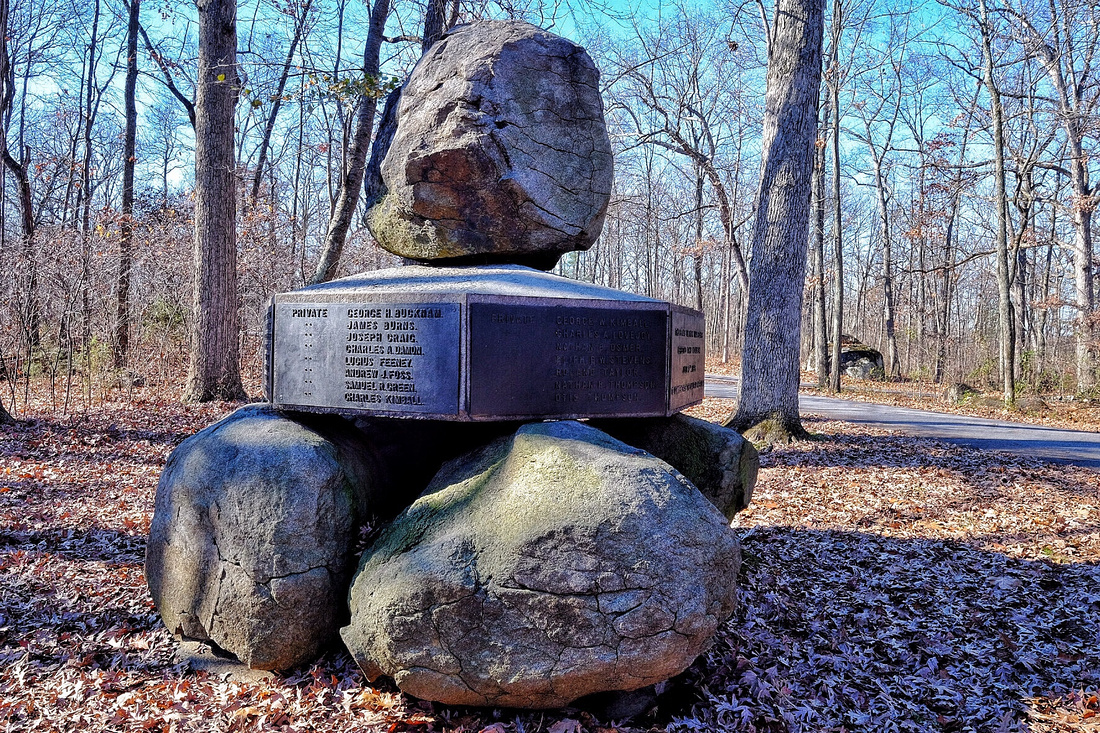
 Foreground - The 5th New Hampshire Monument and location where Colonel Cross was shot in the abdomen; Background - Boulder from which a Rebel sniper fired and mortally wounded Colonel Cross
Foreground - The 5th New Hampshire Monument and location where Colonel Cross was shot in the abdomen; Background - Boulder from which a Rebel sniper fired and mortally wounded Colonel Cross
The 5th New Hampshire Monument - Cross Plaque
The 5th New Hampshire Monument - The Honored Dead Plaques
The 5th New Hampshire Monument - Commemoration Plaque
The 5th New Hampshire Monument - Regiment Plaque
1886 View of 5th NH Monument - Note absence of bronze plaques later installed in 1901 (courtesy of Gettysburg Daily)
Monument Dedication in 1886 - Charles Hapgood, Commander of the 5th at Gettysburg is on the far left (Courtesy Mike Pride)
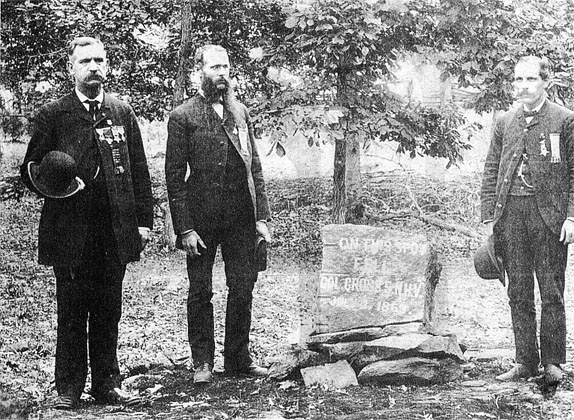
 5th NH veterans (L-to-R, Charles Hapgood, Isaac Hammond, Augustus Sanborn) at the original marker where Cross fell - A few yards behind (east) existing monument (courtesy of Gettysburg Daily)
5th NH veterans (L-to-R, Charles Hapgood, Isaac Hammond, Augustus Sanborn) at the original marker where Cross fell - A few yards behind (east) existing monument (courtesy of Gettysburg Daily)
Modern view showing location of original marker relative to the monument. Four notches on stone match above photo
The Omnipresent General Hancock at Cemetery Hill - "Colonel Cross, this day will bring you a star"
Cross's Brigade Battle Line - Modern View
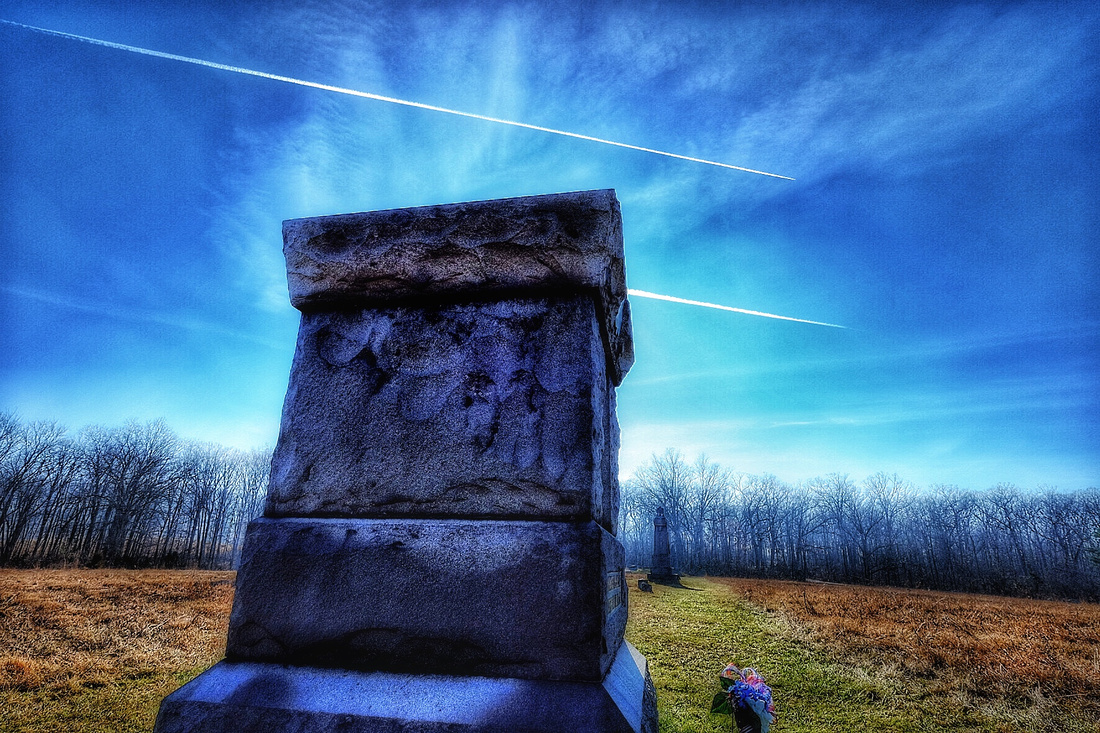
 The Gleam of Bayonets - 61st NY Point of View of Cross Brigade Battle Line
The Gleam of Bayonets - 61st NY Point of View of Cross Brigade Battle Line
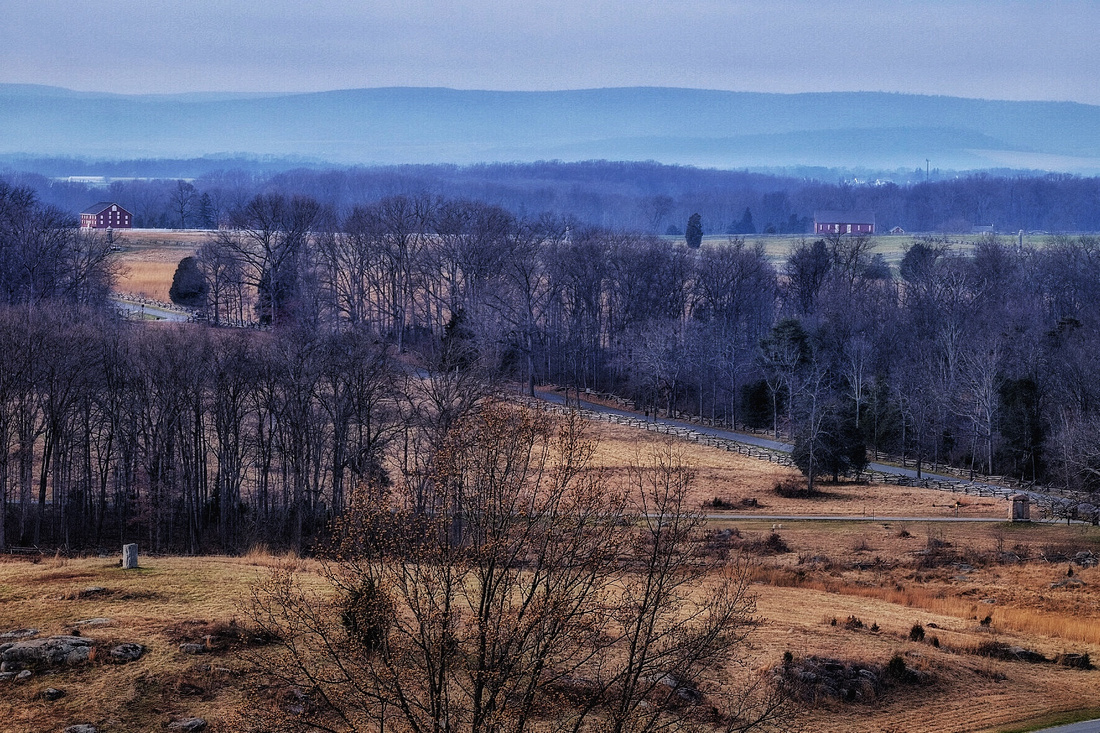
 Middle area is the northern part of the Wheatfield. Stony Hill is off view to the left.
Middle area is the northern part of the Wheatfield. Stony Hill is off view to the left.
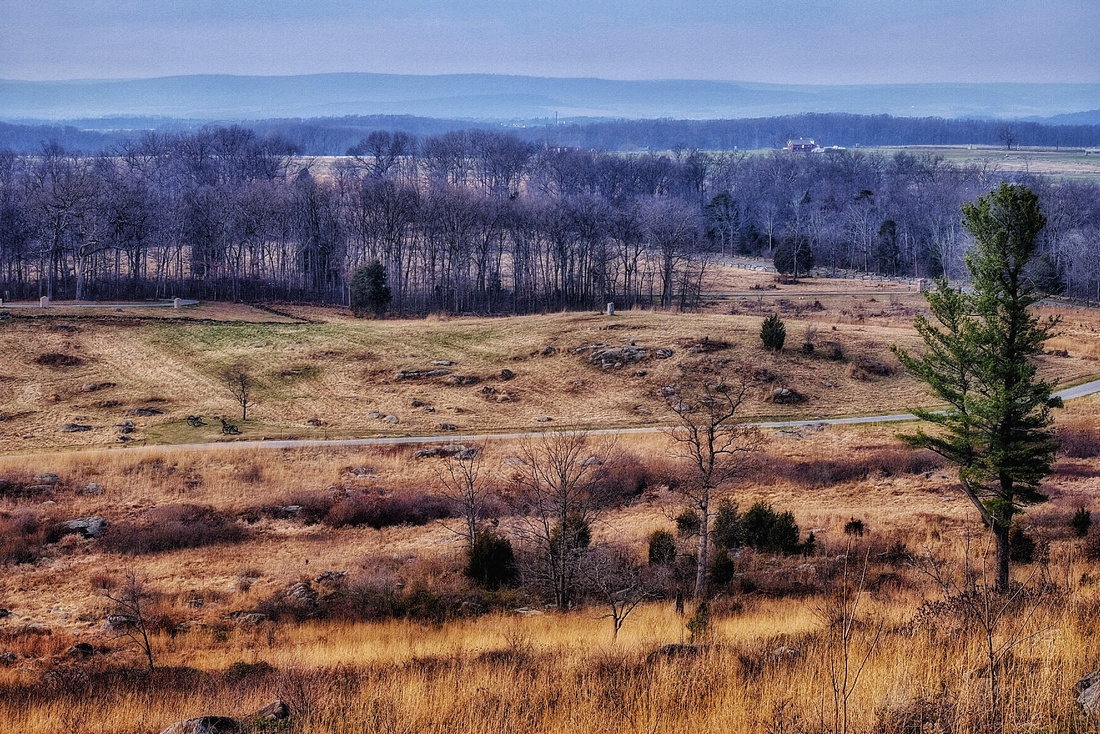
 Behind the middle row of trees is most of the Wheatfield. Stony Hill is behind the loop road on the left - 5th NH monument is in the trees at the very edge of frame.
Behind the middle row of trees is most of the Wheatfield. Stony Hill is behind the loop road on the left - 5th NH monument is in the trees at the very edge of frame.
The 5th NH in the Wheatfield Protecting the Left Flank of Caldwell's Division (map courtesy of the NPS)
